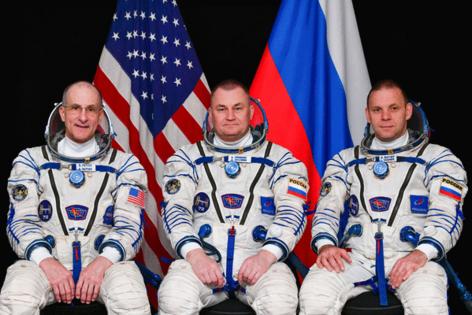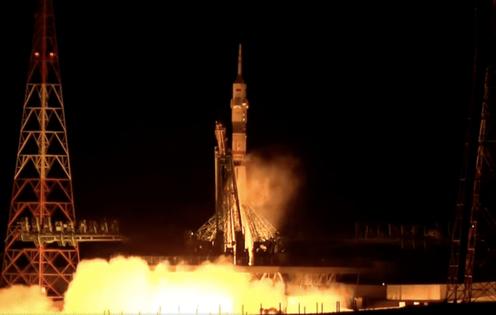Veteran NASA astronaut on Russian launch sets off-world record for people in space
Published in News & Features
NASA astronaut Don Pettit is on his way to the International Space Station with two Russian cosmonaut crewmates who have helped set a record — they’re among 19 people in orbit at the same time.
Pettit, who was part of the 1996 NASA class of astronauts, made his fourth trip to space Wednesday joining Roscosmos cosmonauts Alexey Ovchinin and Ivan Vagner on the Soyuz MS-26 spacecraft.
The trio lifted off at 12:23 p.m. EDT (9:23 p.m. local time) from the Baikonur Cosmodrome in Kazakhstan for a short, two-orbit trip before a rendezvous with the ISS just over three hours later at 3:32 p.m. EDT to join the nine astronauts and cosmonauts already on board the ISS and become part of Expedition 71.
The 12 people on board the ISS isn’t a record for the station, but with the three Chinese taikonauts on the Tiangong space station already in orbit and the four passengers orbiting the Earth on SpaceX’s Crew Dragon Resilience on the Polaris Dawn mission, that will mark a record 19 people orbiting in space at the same time.
The record for people in space including suborbital flights remains 20, when Virgin Galactic flew six people on a minutes-long trip to space in May 2022. They joined at the time 11 on board the ISS and three on board the Tiangong space station, although Virgin Galactic flights don’t cross the Karman line, the internationally recognized line of 100 km or 62 miles, for having made it to space. The U.S. Air Force, though, had defined the line for earning space wings as 50 miles.
Back when the space shuttle flew, the ISS had a maximum 13 people on board at one time, but those totals dialed back since NASA’s shift to flights from commercial providers.
The ISS has two more people on board than its normal crew of seven, though, because NASA astronauts Butch Wilmore and Suni Williams were left behind on the station when their ride, Boeing’s Starliner, departed without them Friday. NASA made the call to keep the duo on board after safety concerns with Starliner’s thrusters, although the spacecraft made a safe return to Earth.
The pair arrived June 6, one day after launching from Cape Canaveral, and won’t fly home until February on board the SpaceX Crew Dragon Freedom, joining the Crew-9 crew, which is set to fly up later this month from Cape Canaveral with only two passengers — NASA astronaut Nick Hague and cosmonaut Aleksandr Gorbunov — instead of four.
Crew-9 is to replace the four members of Crew-8 — NASA astronauts Matthew Dominick, Michael Barratt and Jeanette Epps along with cosmonaut Alexander Grebenkin — already on the ISS. That quartet arrived on the SpaceX Crew Dragon Endeavour last March.
In general, the space station has three crew flown by Soyuz and four crew flown for now by SpaceX Crew Dragon making normal six-month rotations. Starliner is seeking certification to share astronaut ferry duties with SpaceX.
Pettit’s arrival will allow current Expedition 71 member NASA astronaut Tracy Dyson to fly home aboard a Soyuz with ISS crewmates Oleg Kononenko and Nikolai Chub. Dyson arrived in March and will be completing her third trip to space. Kononenko and Chub have been on board the ISS since September 2023 and will have been in space 374 days when they land.
Kononenko is already the record holder for days in space, and by the time he lands will have been in space 1,111 days.
Pettit, 69, who has a Ph.D. in chemical engineering from the University of Arizona, first flew to space on STS-113 in 2002 on Space Shuttle Endeavour to join the ISS on Expedition 6. That mission was the last before STS-107 of Space Shuttle Columbia, which was destroyed on its flight home in January 2003.
The grounding of the shuttle fleet after the disaster meant Pettit was the first NASA astronaut to fly up to the ISS on a space shuttle and return to Earth on a Soyuz spacecraft.
He returned to the ISS on STS-126 also on Endeavour in 2008 and then returned to the ISS flying up on a Soyuz for a more than a six-month stay from 2011-2012.
He has already spent 369 days in space, and by the time he returns will have added another six months, which would make his No. 2 on the NASA astronaut list for most cumulative days in space, only behind former NASA astronaut and now Axiom Space employee Peggy Whitson.
He will become part of Expedition 72 and return next March.
_____
©2024 Orlando Sentinel. Visit orlandosentinel.com. Distributed by Tribune Content Agency, LLC.










Comments